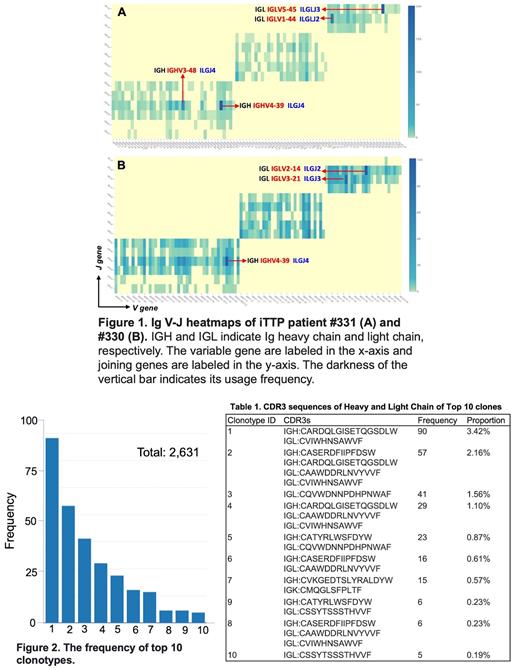Abstract
Introduction. Immune thrombotic thrombocytopenic purpura (iTTP) is a potentially fatal blood disorder, resulting from autoantibodies against ADAMTS13, a plasma metalloprotease that cleaves von Willebrand factor. However, the structural feature, binding epitope, and the mechanism of action of these autoantibodies in patients with acute iTTP are not fully understood.
Methods. To further understand the pathogenesis of iTTP, single B cell immunoglobulin (Ig) sequencing using 10xChromium in 4 patients experiencing an acute episode of iTTP was performed; the expression and preliminary functional characterizations of selected clones were also carried out.
Results. Approximately 2,631 viable and fluoresceinated ADAMTS13 labeled B cells (e.g., 7AAD -CD19 +CD20 +ADAMTS13 +) were sorted out from peripheral blood mononuclear cells of four patients with acute iTTP. These enriched ADAMTS13 antibody-producing B cells were then used for single cell analysis using 10xGenomics 5'-VDJ kit following the manufacturer's instruction. The single-cell gene expression libraries and VDJ libraries were constructed and sequenced by Hiseq at 20,000 reads/cell for gene expression and 5,000 reads/cell for VDJ sequences. Sequencing FASTQ files were mapped and counted by running through the Cell Ranger pipeline, and the final data were then further analyzed by the Loupe browser.
We showed for the first time that the most frequent VJ combinations in the anti-ADAMTS13 IgG were: IGHV4-39:ILGJ4, IGHV3-48:ILGJ4, IGLV1-44:ILGLJ2, GLV5-45:ILGLJ3, IGLV2-14:ILGJ2, and IGLV3-21:ILGJ3 as shown in Figure 1. Of the top ten clones, the most frequently observed CDR3 (complementarity-determining region-3) sequences of these antibodies were CARDQLGISETQGSDLW on the heavy chain and CVIWHNSAWVF on the light chain as shown in Figure 2 and Table 1.
The variable region sequences from the heavy and the light chains of Ig molecules were cloned into a human IgHG1 and a human IgL vector, respectively, which was then cotransfected in HEK293 cells. Western blotting, ELISA, immunoprecipitation, and functional assays were used to determine the expression and the function of human monoclonal IgG antibodies. Our preliminary results demonstrated the human monoclonal IgG antibodies bound and/or inhibited plasma ADAMTS13 activity.
Conclusions. We conclude that there is clonal expansion of ADAMTS13 antibody producing B cells in acute iTTP and the cloned human monoclonal antibodies using the single B cell sequencing approach are functional. Our ongoing analysis on the structural and functional relationship of a large number of isolated human monoclonal antibodies may shed new light on the pathogenesis of iTTP. These antibodies may be useful to explore structural elements required for allosteric regulation of ADAMTS13 activity.
Zheng: AJMC: Honoraria; Clotsolution: Other: Co-founder; Takeda: Consultancy, Honoraria; Sanofi-Genzyme: Honoraria, Speakers Bureau; Alexion: Speakers Bureau.


